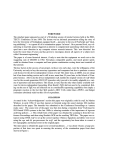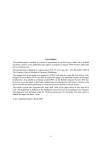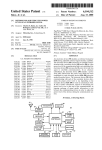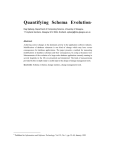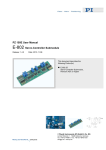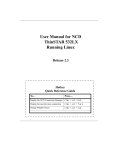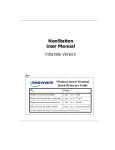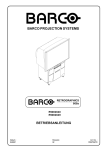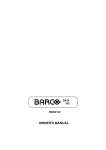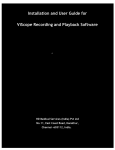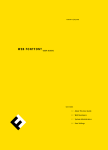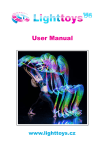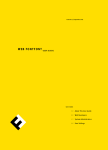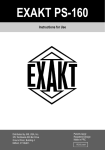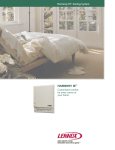Download - Nottingham ePrints
Transcript
FOREWORD
The attached paper appeared as part of a Workshop session of tutorial lectures held at the PROTEXT I Conference in late 1984. The lecture was an informal presentation telling the story of
how the University of Nottingham equipped itself — just prior to the era of PostScript and “desktop publishing” — to typeset all of its examination papers ‘in house’. On a personal level, my volunteering to lead this project triggered an interest in computerised typesetting which later developed into a new direction in my computer science research interests. This ‘new direction’ has
now lasted for more than 20 years and has grown to encompass almost all aspects of a subject
now called ‘document engineering’.
The paper is of some historical interest, if only to note that the equipment we used cost us the
staggering sum of £80,000 in 1982. Nowadays comparable quality, and much greater speed,
could be obtained from a computer and laser-printer combination costing about one twentieth of
that amount.
The key factors in the success of our project, in those very early days, were the willingness of the
University not only to buy the necessary typesetters and computers but also to purchase a source
code licence for the device-independent version of troff. This latter item, at £4000, was not cheap
but it has done sterling service and is still in use, some 20 years later, in the School of Computer
Science. Above all, the device independent troff, (unlike the original version of troff which was
for the second-generation GSI CAT typesetter only) proved to be readily adaptable to a variety of
typesetters and laser-printers. This meant, in turn, that the only other readily available software
for device-independent typesetting (Don Knuth’s TEX) did not need to be considered. Ruling out
the use of TEX was no reflection on its considerable typesetting capabilities but simply a pragmatic reaction to the fact that TEX needed a DEC VAX, rather than a PDP11, and budget constraints absolutely ruled out this sort of expenditure.
COLOPHON
As stated in the ‘Acknowledgements’ section this paper was originally coded up in troff, by Marion Windsor, in early 1984. It was then typeset on bromide using the same Linotype 202 machine
described in the paper. The bromide was submitted to the Conference Proceedings as ‘camera
ready copy’. The source text of the paper was then lost during a transition from VAX-based to
SUN-based UNIX systems in the late 1980s (a sobering reminder of the importance of rigorous
archiving policies …). This rebuilt form of the paper was obtained by scanning in from the Conference Proceedings and then using Readiris OCR on the resulting TIFF files. The paper was retypeset using UNIX troff to set up the correct typeface (Times). Equations and tables were re-set
using the eqn and tbl pre-processors for troff. and the opportunity has been taken to correct a
few typographic and factual errors in the original paper.
The time taken to rebuild this paper (over several lunchtimes …) was about 4 hours; a large proportion of that time was spent in ensuring the accuracy of the examination paper front sheet
shown in Figure 1.
In-house Preparation of Examination Papers using troff, tbl, and eqn
David F. Brailsford
Computer Science Group
University of Nottingham
NOTTINGHAM NG7 2RD
U.K.
ABSTRACT
Starting in December 1982 the University of Nottingham decided to phototypeset
almost all of its examination papers ‘in house’ using the troff, tbl and eqn programs running under UNIX. This tutorial lecture highlights the features of the
three programs with particular reference to their strengths and weaknesses in a
production environment. The following issues are particularly addressed:
Standards — all three software packages require the embedding of commands and the invocation of pre-written macros, rather than ‘what you see
is what you get’. This can help to enforce standards, in the absence of traditional compositor skills.
Hardware and Software — the requirements are analysed for an inexpensive preview facility and a low-level interface to the phototypesetter.
Mathematical and Technical papers — the fine-tuning of eqn to impose a
standard house style.
Staff skills and training — systems of this kind do not require the operators to have had previous experience of phototypesetting. Of much greater
importance is willingness and flexibility in learning how to use computer
systems.
1. Introduction and Background Information
It is a rather strange experience for an academic to be thrown into the role of storyteller and
yet, in this tutorial paper, I shall attempt to convey the philosophy of the troff, tbl and eqn software running under UNIX and to relate our experiences in using it, in a production environment,
at the University of Nottingham for the in-house phototypesetting of a wide variety of material.
Although we have set posters, newsletters, journals, pamphlets and forms using this software, the
majority of the work has been in the production of examination papers and I shall concentrate on
this area in what follows.
It will soon be evident that setting up a system of this nature in less than a year, and conditioning
it for non-expert use, needs coordinated, time-critical, teamwork of an order normally associated
only with jugglers and acrobats. From time to time those particular professions seemed strangely
appropriate as we struggled with software bugs which insisted on replacing line-end characters by
strings of Ws, or with phototypesetters which pumped toner ink all over our feet. Nevertheless the
results we have achieved make us feel it was all worth while and a tribute to the rest of the team
appears in section 2 and in the ‘Acknowledgements’ section.
In common with many other groups, our interest in phototypesetting began when we received the
UNIX operating system and began to run it on our DEC PDP 11/34 computer. Quite apart from
the merits of UNIX as an operating system we were intrigued by the text preparation packages
nroff (for low resolution terminals and printers) and troff (for phototypesetter output on a Graphics Systems Inc. CAT machine).
The nroff and troff programs [Oss1979a] have much code in common but we shall be concentrating on troff from now on. The input format accepted by troff is the classic one of having layout
commands embedded within the text. These commands usually occur at the start of a line and
begin with a . character. Other commands (some of which are merely alternative forms of commands) can occur within a line and are preceded by a \ character. So, for example, the text
.ps 10
.vs 12
.ft HR
This should be in Helvetica whereas this switches back to \f(TRTimes.
asks for a point size of 10 and a vertical line spacing of 12 points followed by a change into the
Helvetica Roman font. Part way through the sentence troff recognises \f(TR as a request to
change font to Times Roman. The net effect is to produce
This should be in Helvetica whereas this switches back to Times.
Troff is amply endowed with dozens of low-level commands for asserting fine control over factors such as horizontal and vertical spacing, hyphenation and the like. To use the input language
in this raw form requires considerable expertise and tenacity, with the danger that the traditional
typesetting technique of making fine adjustments by inserting lead spacers is replaced by the even
more tedious drudgery of calculating such spacings in ems or in machine units.
Clearly, forms of input are needed which express more abstractly and powerfully what the
intended effect is to be. This is accomplished in two ways. Firstly, troff has a macro facility
which enables frequently used sequences of commands to be encapsulated in a single command
name. Files of standard macro definitions can be built up and two useful sets, supplied with
UNIX, are ‘ms’ (for general typing of manuscripts) and ‘man’ (for typesetting the UNIX manual
pages). Macro commands, like the raw troff commands, are preceded by a . but the usual convention for macros is that upper case names are used. As with macro systems in other areas of computer software, the power of a macro approach becomes especially evident when they can be supplied with parameters (or arguments) which control the precise effect obtained. Thus if the .IP
(indented paragraph) command of the ‘ms’ macro package is invoked by typing
.IP hello 7
then the correct spacing motions will occur to set an indented paragraph with hanging tag ‘hello’
and with an indentation of 7 ens.
The second method of making troff accessible to mere apprentices is to provide pre-processors
which allow the user to specify, in a high-level fashion, what is required and which will translate
these wishes into troff commands to effect them. Tbl and eqn follow precisely this philosophy.
The former [Les1979a] allows templates for tables to be set up and for tabulation commands to
be given. It recognises .TS (‘Table Start’) and .TE (‘Table End’) as being delimiters in the input
text between which all typesetting instructions will be in tbl format. Similarly, eqn [Ker1975a]
expects all commands between .EQ and .EN, for displayed equations and between $...$ for
in-line equations in the ‘eqn language’. As a simple example of what can be done the input
.EQ
{gamma + delta sub 2} over sqrt {a sup 2 + b sup 2}
.EN
produces
γ + δ2
√a 2 + b 2
with all calculations of the heights and widths of fraction bar and vinculum being performed
automatically. It goes without saying that preprocessors of this sort can outdo even the most
demented human in terms of the sheer quantity, fluency and dazzling obscurity of the raw troff
output they generate.
2. The Examinations Project
Early in 1982 we were asked by the Examinations Unit at our University to assess whether
a troff based system would be suitable for in-house installation, with the primary aim of typesetting all examination papers over the crucial period from January to May every year. At other
times of the year a typesetting service would be provided for other University material.
At that time, the annual cost of sending examination papers to outside organisations for typesetting was in the region of £18,000 p.a. The situation was particularly aggravated by the requirements of the Mathematics degree examinations where, rather than setting a small number of
papers at the Final Examination, an option scheme had been adopted which produced a separate
two-hour paper for each of about 50 possible options. It will be no surprise to learn that the typesetting and correction of these papers alone would occupy an experienced compositor for fully 6
weeks.
Somewhat nervously our University set aside £35,000 to purchase a pilot system consisting of
DEC LSI 11/23 computer, Linotype Omnitech 2000 phototypesetter and an AT&T Phototypesetter License. An implementation team was set up with the following duties:
D.F. Brailsford
D.R Woodall
G.F.Paechter
W.J. Armitage
J.P. Onions
S.J. Marchant
(project manager; computer and phototypesetter interfacing;
initial version of ‘mex’ macros)
(installation and software management of troff, tbl and
eqn)
(typographical specifications; technical editor; ‘mex’
macro enhancements)
(installation and maintenance of UNIX software; assistance
with interfacing problems)
design of custom hardware, with Z80 controllers, to interface
to parallel ports on Omnitech and Linotype 202 typesetters
3. Software development
3.1. Modifications to troff
At this early stage we were still using the original troff program, as supplied with Version 7
of the UNIX system, whose output was for GSI CAT machine. A considerable amount of work
went into rewriting troff to output codes which would satisfy the T-file format required for driving the Omnitech 2000. A few extra features were also added, in the form of new raw commands,
notably a mechanism for establishing modes such as bold, italic or negative area. Thus, for
example
.md B
This is bold
.md-B
would change into bold-face but would retain the underlying type style (Times, Helvetica etc.).
This obviates the need to stipulate the explicit fonts being used and by re-initialising the type
style in use at the head of the document enables the same material to be produced in a variety of
typefaces without altering the basic text. A problem which this approach raises is what to do
when a given style is not available for the font in use. The solution adopted has been to produce
simulated italic via the ‘slope forward’ facility available on many modern setters. Simulated
emboldening is achieved by overstriking the character 3 times with a tiny horizontal displacement on each occasion. The effect this produces is just about acceptable for sans-serif fonts but is
of course, no substitute for possessing the proper bold font. The facility has been used, in the
main, for emboldening certain mathematical characters that were not available in bold form on
any of our fonts and which needed emboldening when used to denote vectors.
3.2. The mex Macros
An example of a front page of one of our examination papers is shown in Figure l. It will be
immediately apparent that certain standard features such as headings, underlines, indentations of
question numbers, the phrase Turn Over on all pages except the last, and so on, can be set up as
the standard ‘house style’. A macro package called ‘mex’ (Macros for Exams)was written and
has evolved steadily over the past two years. For example the first few lines of Figure 1 were
obtained by typing
.EX 1144
.EQ
delim
global cent
.EN
.UN
.FU S
.ce
Physics
.sp
.ET 10 1983
.ce
PHYSICS HIII (iii)
.sp
.TI 2
.CM
.CR
.PH
3.3. Modifications to eqn
Unlike troff, the eqn preprocessor has only a rudimentary macro capability and the imposition of a house style becomes somewhat trickier. Certain spacing defaults and actions are inherent
in the implementation of eqn keywords, but it is true to say that there is considerable scope for
adjusting the spacing of elements within the equation by use of the ˜ and ˆ characters to denote
full and half-spaces respectively. In principle this gives plenty of control over layout but means
that each equation might possess many such marks to ensure a pleasant appearance. Uncontrolled
use of these spacing characters results in very diffuse and displeasing effects.
With the production of examination papers in mind our resident typographical experts decided to
tune the eqn program with a view to imposing a compact equation style reminiscent of that found
in [Cha1954a]. Many default spacings associated with the centring of equations, space around =
signs and so on were adjusted so as to minimise the number of explicit ˆ and ˜ marks needed
when typing in the paper.
University of Nottingham
FACULTY OF SCIENCE
Physics
PART IIB EXAMINATION, 1983
PHYSICS HIII (iii)
Time allowed TWO hours
Candidates must NOT start writing their answers until told to do so
Candidates may use a self-contained silent electronic calculator in this examination, provided that the make and
type number are noted on the front of the script. Programmable calculators must not be programmed
prior to the examination, and no program in any form may be taken into the examination room.
An indication is given of the approximate weighting of each part of a question by means of
a bold figure enclosed by curly brackets, e.g. {2}, immediately
following that part
Marks will be given for the following where appropriate: understanding the problem; use of
relevant equations; obtaining an answer which is plausible; making realistic estimates for
those quantities that are not given; for clear well labelled diagrams and for practical solutions
to the experimental problems. ALL questions may be attempted. Total marks should be
regarded as out of 80. The following data may (or may not) prove useful.
electronic charge
electronic rest mass
proton’s rest mass
neutron rest mass
Planck’s constant
speed of light
acceleration due to gravity
Avogadro’s number
gas constant
Rydberg constant
Boltzmann’s constant
e
me
mp
Mn
h
c
g
NA
R
Ry
kB
=
=
=
=
=
=
=
=
=
=
=
Bohr magneton
µB =
Stefan’s constant
gravitational constant
σ
G
=
=
fine-structure constant
α
=
permittivity of free space
permeability of free space
radius of the earth
molecular weight of air
γ ( = cp / cv ) for air
ε0 =
µ0 =
RE =
=
=
1.602 1918 × 10−19 C
0.9109547 × 10−30 kg
1.6726 × 10−27 kg
1.6748 × 10−27 kg
6.626 1933 × 10−34 J s
2.997 924 580 × 108 m s−1
9.8 m s−2
6.022 098 × 1026 kmol−1
8.3145 J K−1 mol−1
13.6058 eV
1.380 50 × 10−23 J K−1
eh̄
= 9.274 10 × 10−24 J T −1
2m e
5.6703 × 10−18 W m−2 K−4
6.673 × 10−11 N m2 kg−2
e2
= (137.035 96)−1
4π ε0 h̄ c
8.85419 × 10−12 F m−1
4π × 10−7 H m−1
6.378 × 106 m
28.8 g mol−1
1.40
Figure 1: Front page of a sample examination paper
This approach marks out a rather different philosophy than the one that is implicit in the original
program. Perhaps the only way to reconcile the two is for eqn to be re-written so as to externalise,
as string definitions or as tables, all the parameters which might potentially need to be adjusted to
accommodate a given house-style. But it has to be admitted that attempts to make eqn more independent of the ultimate output device are not as easy as would appear at first sight. Ideally, of
course, eqn simply feeds its output into troff, which ultimately drives the phototypesetter. In practice many of the details of the particular mathematical symbols available and their sizes will
inevitably affect eqn’s strategy. Good example of this can be seen with integral signs, ∫ , and
square brackets [. It is clear from the source text of eqn that, on the original GSI CAT typesetter
at Bell Laboratories, these are composite symbols made up from a ‘kit of parts’ comprising vertical and horizontal bars, arc segments and so on. On our Linotype fonts however, we possess each
of these symbols explicitly at 3 different sizes. Heated arguments took place, of almost theological intensity, as to where the overlap should occur, in point size terms, between magnifying a
small version of ∫ and diminishing a larger one — and whether the stem weights were then acceptable, and so on.
4. Hardware
The pilot project from April 1982–November 1983 was conducted on a LSI 11/23 running
UNIX and driving an Omnitech 2000 phototypesetter. This system was successful in producing
all the technical examination papers for 1983. Its performance was limited by the slowness of the
LSI II even when driving only two terminals but even more severely by the slowness and unreliability of the Omnitech. This particular typesetter made a brave and far-sighted attempt to dispense
with bromide and to use a laser driven raster scan system to set text onto electrically charged
paper. The overall technology is akin to photocopying in many respects but the problems of backlash on the drum drive and leaks in the plumbing for the toner ink nearly drove us to distraction.
Fortunately, this machine has now been withdrawn from the market to be replaced by the much
more reliable Linotype 101.
For our part we replaced the pilot system in November 1983 with a PDP 11/44 computer driving
a Linotype 202 phototypesetter. Although based on older technology, the 202 positively gallops
through the work and the 11/44 copes fairly cheerfully with driving up to six terminals and the
202 typesetter. The Omnitech 2000, now put out to pasture in the Main Library, is also driven
from the 11/44 via a remote serial link.
5. Interfacing
5.1. Hardware
There have been few major problems here. For reasons of price and performance we have
purchased parallel interfaces on both our typesetters but we drive them down a conventional multiplexer serial line. The necessary serial-to-parallel conversion, buffering and parity checking is
carried out by a Z80 single- board computer. The software for this interface was written using the
Whitesmiths C cross-compiler, hosted on the PDP11 and LSI11, and producing code for the Z80.
This code was, in turn, burned onto an EPROM mounted on the Z80 single-board computer.
5.2. Software
After spending almost two years modifying troff you can imagine the software implementers’ joy at discovering that a more modern, and typesetter-independent, version of troff had
existed all along. This version, [Ker1982a] now known as DITROFF (Device Independent troff),
produces a low-level device-independent code for driving a variety of output devices. We have
christened this code DIC (Ditroff Intermediate Code) and its presence makes the interfacing of
new output devices much easier than before. A ‘back end’ program has to be written to convert
the DIC into the particular codes required by each target phototypesetter, but with example code
available from other driver programs this enables a working driver to be fabricated in about a day,
and a sophisticated one within a week.
The over-riding requirement for any software running in the typesetter is that it must be at a similar low level of abstraction as DIC itself and should allow the setter to be driven in a slave mode.
That is to say, it should support absolute and relative spacing commands at the full resolution of
the machine. Suitable primitives for point size change, font change, reverse area etc. should also
be supplied. Any higher-level software which, for example, insists on re-justifying the text which
troff has already justified, or which limits the accuracy with which superscripts and subscripts can
be placed, should be politely but firmly refused.
Fortunately the T-file language on the Omnitech and the Binary Byte language on the 202 have
been at about the right level and have proved very suitable for our needs.
6. Preview facilities
One lingering problem that faces us is the provision of preview facilities, at modest cost, for
our operators, so that the final phototypeset effect can be judged and proofread before committing
it to bromide. We have had some limited success in this area using DEC VT102 terminals
equipped with Digital Engineering Retrographics units but reliability problems and the slowness
of the processor on the Retrographics board have held us up. More sophisticated preview facilities are available under UNIX System V on the BLIT (now Teletype 5620) terminal but these are
still rather expensive at the time of writing.
7. Operator experiences
The handful of people who control the keyboarding of the examination papers have all had
a good educational background but do not possess any particular mathematical skills. We were
fortunate, in the early days, to be able to recruit a person with some experience of computers, typing and the publishing trade. But with only a few exceptions even the later, inexperienced, operators have learned very quickly how to transform an initial handwritten or typewritten version of
an examination paper into a mixture of text, troff commands and eqn commands.
The originals for the paper are marked up by our technical editor in troff and eqn notation, but
only to give occasional guidance where a rather abstruse combination of commands is needed to
achieve the desired effect. It can be noted at this point that a potent advantage of the troff/eqn
embedded commands approach is that standards can be imposed and maintained. If the paragraph
indentation caused by a call of the .PP macro is inappropriate or if an eqn command such as
$a sup 2$ results in an improperly placed superscript then we know it is not a mistake on the
operator’s part but instead an indication of the need for an adjustment in the details of the .PP
and sup implementations.
8. User reactions
Later stages of proof reading are carried out by the technical editor and ultimately by the
lecturer who set the paper. There is widespread appreciation of the fast turnround of proofs especially since the commissioning of the 202 and there is broad agreement that out standards now
meet or exceed those which we obtained when our papers were sent outside the University for
setting.
There was some initial confusion among proof-readers, during the early stages of tuning the software, when an over-zealous tweaking of some software parameter might cause a torrent of errors
to appear in a paper that had previously been all right. It proved quite hard to convince members
of academic staff that the perceived errors were of a similar nature and that they would all disappear, simultaneously, after a little more surgery on the ‘mex’ macros or on eqn.
By contrast, of course, a more interactive scheme with ‘what you see is what you get’, without
macro assistance, is closer to the traditional way of setting type, but demands intense concentration to ensure that the house-style is maintained.
9. Conclusions
By any standards our experiment has to be judged a success. The savings made by our University in typesetting examination papers and other material in-house will be sufficient to nullify
the £80,000 cost of the PDP 11/44 computer and Linotype 202 phototypesetter after only two
years. We see further potential benefits in future from the UNIX/DITROFF combination. For
example, the UNIX environment would enable a database of student records to be kept on disc
and, at appropriate times, items such as degree certificates, registration cards etc. could be produced on a range of output devices such as phototypesetters and laser printers.
So far there has been a lot of interest in the use of the UNIX phototypesetting software. However,
the market for such technically orientated setting is rather limited and so there are few if any turnkey systems available. With this in mind it is clear that much of our success can be attributed to
the fact that although we lacked some of the traditional composing and typesetting skills we did
have to hand a fair body of expertise in mathematical typography, mathematics and computer science.
A system such as ours, as it stands, would perhaps be unacceptable to ‘the trade’ where a more
interactive, ‘wysiwyg’, approach might be favoured. Nevertheless we feel sufficiently convinced
of the merits of describing what you want, in eqn notation rather than the more difficult task of
maintaining standards and style when repetitively doing what you want, that we are happy to
maintain the approach of tagged input to troff and eqn, provided that we can have an output preview capability of some sort before committing ourselves to the creation of film or bromide.
10. Acknowledgements
I should like to thank the Registrar and Deputy Registrar of the University of Nottingham
for suppressing any misgivings they may have had and for supporting us in this project. The
Examinations Unit supervisor, Betty Hickling, and all her staff, have remained stoically cheerful
through many software changes, floods of ink and the occasional bolt of lightning to the PDP
11/44. Brian Kernighan provided much helpful advice on his typesetter-independent version of
troff together with a fascinating technical report of work at Bell Laboratories in ‘reverse engineering’ the Linotype 202 so that it could be driven, as a slave device, at a coding level even lower
than Binary Byte.
Thanks also to Marion Windsor for typing this paper and for her hard work in the early days of
commissioning the Examinations system. I do not dare to add up the man-hours contributed by
those named in Section 2, but it goes without saying that the successful outcome of this project is
a tribute to many late-night sessions labouring over source code, macro modifications and hardware interface testing.
References
Oss1979a. J.F. Ossanna, “NROFF/TROFF User’s Manual”, UNIX Programmer’s Manual 2, Section 22
(January 1979).
Les1979a. M.E. Lesk, “Tbl — A Program to Format Tables”, UNIX Programmer’s Manual 2, Section 10
(January 1979).
Ker1975a. B.W. Kernighan and L.L. Cherry, “A System for Typesetting Mathematics”, Comm. ACM
18(3), pp.151–157 (1975).
Cha1954a. T.W. Chaundy, P.R. Barrett, and C. Batey, The Printing of Mathematics, Oxford University
Press, Oxford (1954).
Ker1982a. B.W. Kernighan, “A Typesetter-independent TROFF”, Comp. Sci. Tech. Rep., Bell Laboratories, Murray Hill, NJ (March 1982).










